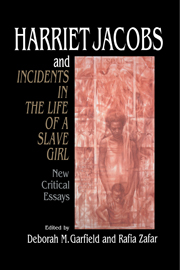Book contents
- Frontmatter
- Contents
- Introduction: Over-exposed, Under-exposed: Harriet Jacobs and Incidents in the Life of a Slave Girl
- “I Disguised My Hand”: Writing Versions of the Truth in Harriet Jacobs's Incidents in the life of a Slave Girl and John Jacobs's “A True Tale of Slavery”
- Through Her Brother's Eyes: Incidents and “A True Tale”
- Resisting Incidents
- Manifest in Signs: The Politics of Sex and Representation in Incidents in the life of a Slave Girl
- Earwitness: Female Abolitionism, Sexuality, and Incidents in the life of a Slave Girl
- Reading and Redemption in Incidents in the Life of a Slave Girl
- Harriet Jacobs, Frederick Douglass, and the Slavery Debate: Bondage, Family, and the Discourse of Domesticity
- Motherhood Beyond the Gate: Jacobs's Epistemic Challenge in Incidents in the Life of a Slave Girl
- “This Poisonous System”: Social Ills, Bodily Ills, and Incidents in the Life of a Slave Girl
- Carnival Laughter: Resistance in Incidents
- Harriet Jacobs, Henry Thoreau, and the Character of Disobedience
- The Tender of Memory: Restructuring Value in Harriet Jacobs's Incidents in the Life of a Slave Girl
- Conclusion: Vexed Alliances: Race and Female Collaborations in the Life of Harriet Jacobs
- List of Contributors
- Index
- CAMBRIDGE STUDIES IN AMERICAN LITERATURE AND CULTURE
Through Her Brother's Eyes: Incidents and “A True Tale”
Published online by Cambridge University Press: 22 January 2010
- Frontmatter
- Contents
- Introduction: Over-exposed, Under-exposed: Harriet Jacobs and Incidents in the Life of a Slave Girl
- “I Disguised My Hand”: Writing Versions of the Truth in Harriet Jacobs's Incidents in the life of a Slave Girl and John Jacobs's “A True Tale of Slavery”
- Through Her Brother's Eyes: Incidents and “A True Tale”
- Resisting Incidents
- Manifest in Signs: The Politics of Sex and Representation in Incidents in the life of a Slave Girl
- Earwitness: Female Abolitionism, Sexuality, and Incidents in the life of a Slave Girl
- Reading and Redemption in Incidents in the Life of a Slave Girl
- Harriet Jacobs, Frederick Douglass, and the Slavery Debate: Bondage, Family, and the Discourse of Domesticity
- Motherhood Beyond the Gate: Jacobs's Epistemic Challenge in Incidents in the Life of a Slave Girl
- “This Poisonous System”: Social Ills, Bodily Ills, and Incidents in the Life of a Slave Girl
- Carnival Laughter: Resistance in Incidents
- Harriet Jacobs, Henry Thoreau, and the Character of Disobedience
- The Tender of Memory: Restructuring Value in Harriet Jacobs's Incidents in the Life of a Slave Girl
- Conclusion: Vexed Alliances: Race and Female Collaborations in the Life of Harriet Jacobs
- List of Contributors
- Index
- CAMBRIDGE STUDIES IN AMERICAN LITERATURE AND CULTURE
Summary
When I first read John S. Jacobs's slave narrative, “A True Tale of Slavery,” I thought it an exciting corroborative text. Engaged in the double task of establishing Harriet Jacobs's Incidents in the Life of a Slave Girl as an African American text and as an autobiography, I welcomed her brother's narrative because it corroborates some of the most outrageous claims made by Jacobs's alter ego Linda Brent – including her assertion that she hid in Grandmother's house, within earshot of her vindictive master, for almost seven years. Further, I thought John S. Jacobs's narrative important because it gives additional detailed information about Jacobs's life. “A True Tale” includes the first initial of proper names, for example, so tentative identifications of various individuals could be corroborated. Further, it gives information that Incidents omits – for instance, it carefully explains Grandmother's ownership of her oldest son, and it clearly describes the architecture of the “loophole of retreat.”
But I also valued “A True Tale” for other reasons. I had already realized that Harriet Jacobs chose a unique subject for her book. Although Frederick Douglass had described the brutalities inflicted upon his Aunt Hester, and William Wells Brown had recorded Patsey's suffering, only Harriet Jacobs wrote an antebellum slave narrative in which the sexual oppression of slave women and their struggle against this oppression is central. In addition, I had known that Harriet Jacobs created two interlocking texts: her public writing – the pseudonymous slave narrative Incidents – and her private letters to her friend Amy Post that discuss the inception, composition, and publication of her book.
- Type
- Chapter
- Information
- Harriet Jacobs and Incidents in the Life of a Slave GirlNew Critical Essays, pp. 44 - 56Publisher: Cambridge University PressPrint publication year: 1996
- 3
- Cited by



